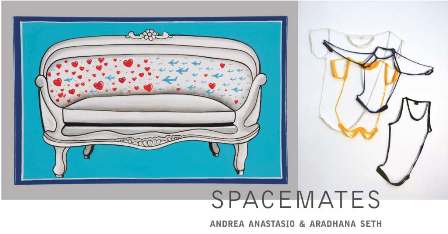An art project to explore Indian living spaces
 New Delhi, Jan 31 : Every man carries a room inside him, Franz Kafka wrote in "The Blue Octavo Notebooks".
New Delhi, Jan 31 : Every man carries a room inside him, Franz Kafka wrote in "The Blue Octavo Notebooks".
The concept of "Spacemates" - objects peopling domestic space - has, however, become fluid with shrinking living spaces and rapidly changing household accessory design. Yesterday's art deco interiors have given way to today's utilitarianism and minimalism, and each object is defined by multiple purposes - utility, affordability, uncluttered lines and minimum space occupied.
Leading Indian conceptual artist and filmmaker Aradhana Seth, sister of writer-poet Vikram Seth, and Italian artist Andrea Anastasio have now collaborated on an on-site art project, "Spacemates", looking at transforming Indian living spaces, which are at a premium and expensive.
The month-long Indo-Italian art project opened at the Italiano di Cultura (Italian Cultural Centre) Tuesday.
The project was mounted after an intensive three-week "sweatshop" by the two artists, who used the two galleries as their studio, putting together the material and art works.
Material is central to the installations, and the primary object is the humble pillow, made locally and covered in cotton textile with floral motifs.
The pillows take up one of the galleries in a centrepiece, "This is not a Love Song", inspired by Checkpoint Charlie-type barricades, that scan vehicles for possible bombs and terrorists. The pillows are arranged like sand-bunkers - security posts.
The main installation is surrounded by smaller cushions bunched together with plastic flowers on the floor and on the ceiling, like remains of mayhem.
The checkpoint is placed between the living room and bedroom.
The colours on the 60-odd pillows, as the artists explain, serve as a symbol of class division as well.
"It is very important for me to engage with something used in daily life. Seeing is also framed by thought, and I wanted to relate to the wonderful minds with my work," artist Andrea Anastasia, a scholar of eastern philosophy and a conceptual designer, told IANS.
Explaining the synergy between social psychology, home design, art and political movements, Anastasio said: "Soon after World War II, functionality of home design was contaminated by language". The main focus of home decor after the war was, in the Italian designer's words: "To sit in the living room and share socially and politically."
In the 1960s, the "socialist" decor of living-room bonding was replaced by new age minimalism, and the designer gave up a personal style for "minimal language and spartan use of material".
In the 1990s, this common ground and minimalism were "contaminated" with style - a "personal romantic idea of uniqueness", Anastasio explained, offering a context for design trends.
Anastasio is showing three installations. "Amnesia 2013" comprises patterns in cement "jaalis" (lattices) covered with wallpapers. "Jaalis with beautiful wallpapers remind me of a 'zenana' - the royal women's quarters and symbol of gender in another place in another time. The "jaalis" are like membrane. We all have a skin and that skin is a very plane to work with," Anastasio told IANS.
"Fishing Tank 2013" conveys the sense of domestic space through a series of paintings with "shopping bags hemmed in between glass and plywood to create abstract forms".
Anastasio, who moved to India in 1991, met Aradhana Seth while working on a book project. Their mutual affinity drew them to work together on "objects that depict both fiction and reality".
Space and domestic objects were natural choices. "Spaces have shrunk and values have changed. Some people have a manic amount of space, while others don't. People are selling out beautiful spaces - their ancestral space to build high-rises," Seth told IANS.
Seth has used the machine and generator rooms of the Institute as gallery for her installations and art works, mimicking the "quaint living spaces in space-starved megapolises like Mumbai where, say the caretaker of a high-rise, could be washing clothes in the machine room and using it as his domestic space".
"The whole family could be living in the living room," she explained.
Seth explained that her art works are an extension the exhibition, "Everybody Carries a Room..." at the Chemould Prescott Road Gallery in Mumbai, which explored the relevance of space in contemporary art. (IANS)